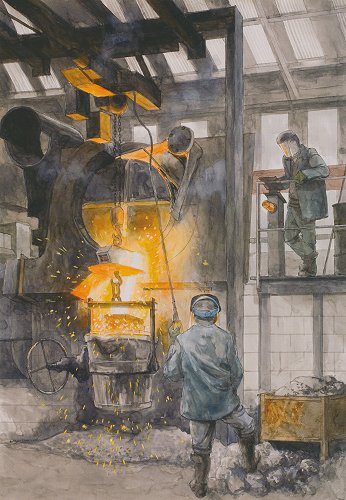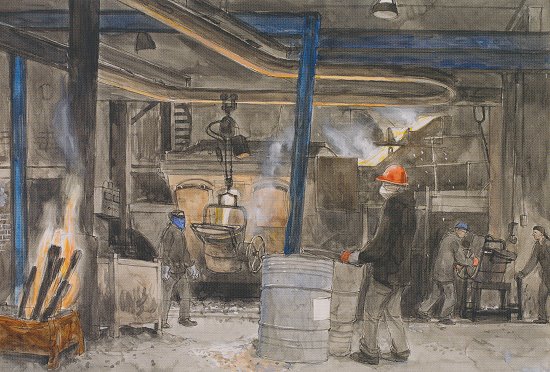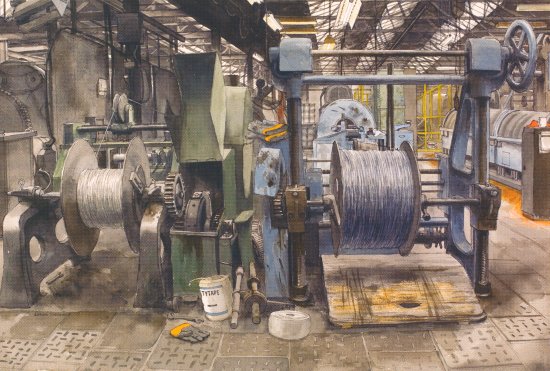|
Industrialisation in the West Midlands
Thanks to the coming of the canals and
railways, and the vast local deposits of coal, iron ore, and
limestone, the West Midlands became the country’s industrial
heartland, and remained as such for nearly 200 years. Much
of the area was dominated by factories, chimneys, and
furnaces. Even in the more rural areas there would be a
chimney or pall of smoke on the sky line. At night the sky
filled with a red glow from countless foundries and steel
works, and the silence was broken by the sound of heavy
industry.
I grew-up in Darlaston where factories
were a frequent sight, they were almost everywhere. Although
many people will not be familiar with the old industrial
landscape, it had a beauty all of its own, both awe
inspiring and dramatic.
The unthinkable started to happen in
the late 1970s when factories started to close, mainly
because of their inability to compete with rising levels of
foreign competition. The industries that offered jobs for
everyone, and social activities in works social clubs,
became unfashionable, and vast areas fell into dereliction.
In our modern post industrial society
we eagerly embrace the new, and only too quickly discard the
old. We are creatures of our past and our industrial
heritage has made us what we are today. Sadly old factories
and machinery have little value and we have too few museums
in which to display them.
Over the last twenty years the
landscape has changed beyond recognition. Most of the old
factories have gone, and areas have been redeveloped to such
an extent that it’s now difficult to visualise the
once-familiar industrial landmarks, or decide exactly where
they stood. Younger and future generations will have no
concept of what factory life was really like, unless we
preserve what remains.
Over the years, a few artists have
recorded the industrial scene, but none like Arthur
Lockwood, an accomplished artist, who for over twenty five years
has been accurately portraying all aspects of the industrial
landscape, from buildings and machinery, to the factory
workers, and their daily tasks. His unique work is an
invaluable record of lost industries and working lives.
Arthur’s wonderful paintings are, and will continue to be a
marvellous resource for anyone who is interested in our
industrial heritage. They recapture the atmosphere of the
industrial towns and factories to such an extent that it’s
easy to imagine you are actually there.
Arthur's Father
Arthur's
father Frank T. Lockwood, also an accomplished artist, came
from Linthwaite near Huddersfield and attended a local art
college. After being demobbed at the end of the First World
War, he came to Birmingham where he acquired a job with
Cadburys as a commercial artist. He worked his way up the ladder and
ended-up in charge of the studio, where many publications
were produced, including a series called ‘Our Birmingham’,
and ‘Conurbation’, a book that looked at how Birmingham and
the Black Country would be planned after the Second World
War. There were also educational books and general books
covering a wide range of topics.
|
|

Frank Lockwood's view of the Tipton canal,
painted in 1953. |
Frank Lockwood painted mainly landscapes in the English
topographical tradition, featuring buildings, churches, and
village scenes. He became a member of Birmingham’s art
societies including the Birmingham Art Circle, the Birmingham
Watercolour Society, and the Easel Club.
He was also an associate member of the Royal Birmingham
Society of Artists, and exhibited with them all. |
| Some of his wonderful paintings are occasionally on
display at the Birmingham Museum and Art Gallery. They have
a website at
http://www.bmag.org.uk/.
Arthur Lockwood
Arthur was born in Birmingham in the 1930s and began
drawing and painting at an early age. His father actively
encouraged him to paint, and from the age of nine Arthur went with his
father on his painting outings, and learned to paint and
draw on the spot. They also drew and painted together during
family holidays. |
| Arthur's fine view of Darcast
Components Limited in Rabone Lane, Smethwick, showing the
foundry's two cupola furnaces and chimney which have since
been removed.
It was painted in 1990. In
the foreground is part of Telford's main line on the BCN,
the most important canal in the area. |
 |

Pouring molten metal into a ladle from
an electric furnace at Sidney Smith Castings in Stourbridge. |
From 1949 to 1951 Arthur attended
Bournville School of Art, followed by the Birmingham College
of Art. He then studied graphic design at the Royal London
College of Art, and remained in London doing freelance
design work for numerous publishers. In 1984 he began
painting in watercolour again, and in 1987, Arthur, and his
wife Gillian, who is a potter, decided that they wanted to
do more of their own work, and so they moved to the Midlands
because of the interesting local subject matter.
Arthur wanted to record what went on in
the area, particularly changes in the disappearing local
industries, which were not well documented. He began to
paint urban and industrial landscapes, including many
buildings and factories that have since been demolished. His
marvellous paintings have become an invaluable record of a
vanishing world, much of which had previously not been
documented.
His paintings go right to the heart of
a scene, accurately capturing the atmosphere. They are so
precise that the viewer can easily imagine being there, to
experience the sights and sounds of a long-gone street or
factory for themselves. |
| Filling a ladle from the Birlec
electric induction furnace at Crane Cast in Wolverhampton.
The furnace was fed from two cupolas
and acted as a reservoir, so that ladles could be filled
when necessary.
Sadly the foundry closed in January
2006, only a few months after Arthur's painting was done. |
 |
| |
|
|
View some of
Arthur's paintings of the Crown Nail Company |
 |
| |
|
 |
In 2007 Arthur produced his first book
of paintings called ‘Change in the Midlands’, published by
Sansom & Company, which is now out of print. He now has a
second book ‘Arthur Lockwood urban and industrial watercolours of Birmingham
and the Black Country’ also published by Sansom & Company.
It appeared in the autumn of 2012 and is available on the
internet, or from the publishers.
It contains 355 full colour illustrations of paintings by Arthur, his father,
and his son Paul.
It is a must for anyone who is interested
in Birmingham and the Black Country. |

A large hammer in operation at Stokes
Forgings Dudley Limited. In the centre is the rolling mill
which forms a billet into a rod in readiness for forging. |
| One of Arthur's lovely street
scenes which shows the Garrison Tavern in Birmingham. |
 |
 |
An exterior view of Hughes
Johnson Stampings Limited of Mill Lane, Langley.
Sadly the factory had closed before Arthur
got there in 1991. |
| A wonderfully detailed and
atmospheric view of Shop R at Latch & Batchelor's factory in Hay
Mills, Birmingham where steel wire rope is made.
Painted in January 1998. |
 |
|
Sadly Arthur passed away on the 3rd
June, 2019 at the age of 85. His paintings are a wonderful
legacy to us all, recalling a time when industry dominated
the Black Country and Birmingham. It is worth keeping an eye open for any
exhibitions that include some of Arthur’s work. His
paintings will bring back memories to many people, and
introduce others to a way of life that has almost
disappeared.
|

|
Return to
the
art gallery |
|